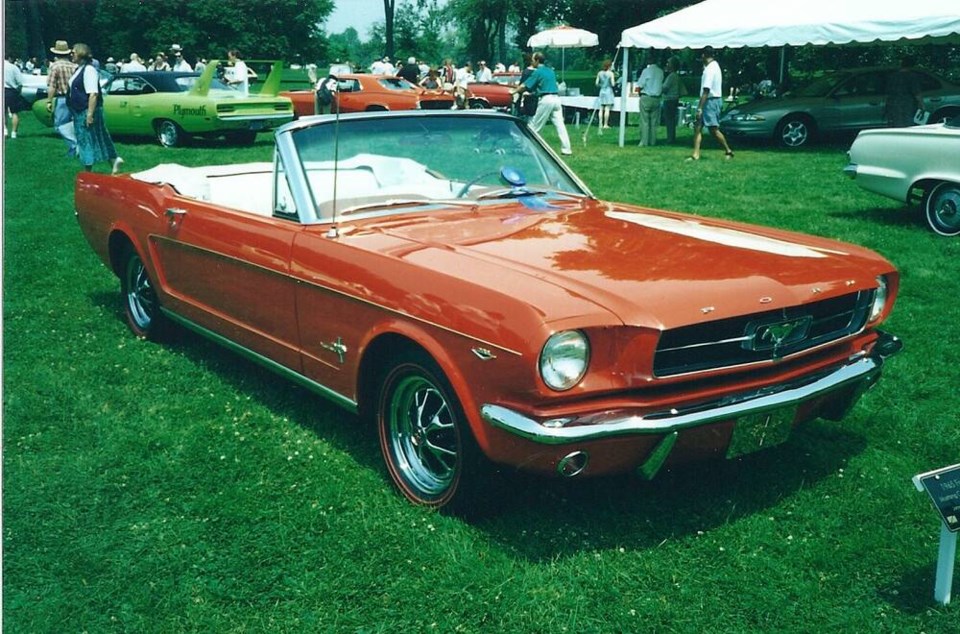The segment of the market that became known as the Pony Car was born in April, 1964 with the arrival of the 1965 Ford Mustang, a sporty four seater with a low slung stance, long-hood and short deck. Being based on compact Ford Falcon mechanicals kept the price reasonable.
In spite of its modest heritage, the stylists and engineers had created a kind of American sports car, and four passenger convenience made it far more practical than traditional English roadsters. It was quickly nicknamed the Pony Car.
The Mustang was a sensation, catching the wave of young buyers seeking style, performance and affordability. Within four months more than 400,000 were sold. Ford Division president Lee Iacocca became known as the “Father of the Mustang,” on his way to becoming the president of Ford Motor Co.
The Mustang came as a convertible and hardtop and offered enough options to transform it from plain and practical to speedy and sporty. Engines ranged from the standard overhead valve 2.8 litre (170 cu in.) 101 horsepower inline six to a 4.2 litre (260 cu in.; soon to be 4.2/289) overhead valve V-8 with a four-speed, floor-shift manual transmission. Base gearbox was a three-speed manual, with automatic optional.
Ford Motor Co. caught the competition flatfooted. Although the Plymouth Barracuda, basically a Valiant with a huge wrapover rear window, had arrived just before the Mustang, it was overwhelmed by the Mustang’s popularity.
Others knew they needed a competitor but it took General Motors until the 1967 model year to offer its Chevrolet Camaro Mustang challenger. While the rear engine Chevrolet Corvair Spyder with four-speed manual and turbocharging was quite sporty, it couldn’t accommodate a V-8 engine.
The Camaro followed the Mustang’s lead in form and function. It used Chevy II underpinnings draped in a close-coupled, four-seater body with the mandatory long hood-short deck profile. Like the Mustang, it offered a variety of engine options, from the 3.8 litre (230 cu in.) inline six to a 6.5 litre (396 cu in.) V-8.
Others quickly followed. Lincoln-Mercury Division’s Mercury Cougar came as a 1967 model. It used many Mustang components, but with styling that set it apart as something a little more upscale.
Pontiac having cultivated a strong performance image with its racing success and 1964 GTO Muscle Car wanted a Pony Car too. The mid-1967 Pontiac Firebird was basically a Camaro with Pontiac power.
Like Mustang and Camaro it offered a wide range of engines starting with its new overhead cam inline six, which was a Chevy six with the pushrods replaced by a belt-driven overhead camshaft.
American Motors, after a false start with its too-large, mid-1965 fastback Marlin based on the Classic sedan, got into the game properly with not one but two 1968 Pony Cars. The most popular was the Javelin, which followed the Pony Car formula. The other was the AMX, a short-coupled version of the Javelin created by taking 305 mm (12 in.) out of the Javelin’s wheelbase and overall length. It was the only two passenger Pony Car.
Dodge finally entered the Pony Car market in 1970 with its Challenger, which was very similar to the redesigned Plymouth Barracuda. The Challenger offered everything from a slant six to a 425 horsepower Hemi V-8.
Light, agile cars that could be loaded with horsepower just begged to be raced, so for 1966 the Sports Car Club of America established the Trans-Am racing series.
Pony Cars were a natural and after a tentative start, manufacturers were fighting it out tooth-and-nail on tracks all over North America. The Mustang won the 1966 season and Cougar the 1967, a one-two punch for Ford Motor Co.
Camaros took the Trans-Am for the next two years, setting the stage for a grand slam 1970 season when every factory except General Motors was into Trans-Am racing. GM had an official ban on racing, but was likely providing under-the-table assistance.
Even smaller American Motors contested the series with famous driver Mark Donohue who had previously raced Camaros. Donohue drove a factory-backed Javelin team managed by the redoubtable Roger Penske.
Mustang, the original Pony Car won the 1970 Trans-Am series, the high point of Pony Car racing popularity. Most factory participation ended with the 1970 season, although the series carried on.
As with the racing, general interest in Pony Cars began to fade early in the 1970s as emission controls and the lower compression ratios required by lead free gas sapped power. Insurance rates also rose dramatically. Pony Cars gradually faded away until only the Mustang survived by staying true to its Pony Car roots.
Eventually the revived Chevrolet Camaro and Dodge Challenger came back and the Mustang continues, but we are unlikely to see a return of the American Pony Car’s 1960s glory days.



